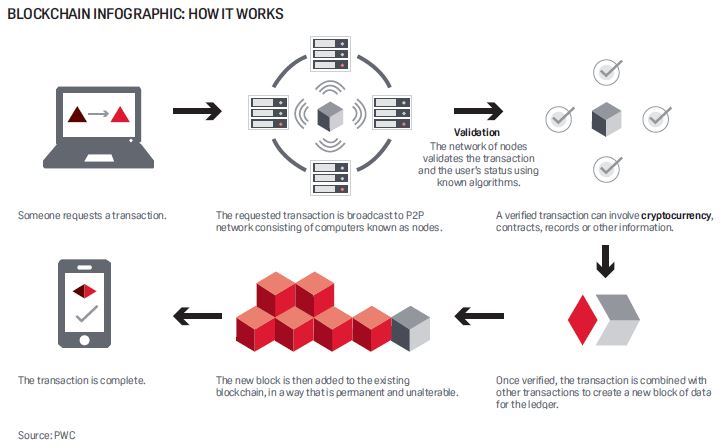Blockchain and the Future of Energy
Blockchain is coming to the energy world and its impact will be massive. It will accelerate the transition to renewables and give us real and immediate ways to combat global warming, incentivize the production of renewable energy, and replace fossil fuels.
What is blockchain?
If you've heard of Bitcoin, blockchain is the technology that powers it. Blockchain allows data to be recorded on a distributed ledger in a way that cannot be changed.
Why does it matter?
The key benefit of blockchain as a technology is that it enables parties that do not know each other or trust each other to do business together and still feel secure. Applications running on the blockchain can take advantage of smart contracts that trigger certain events (for example, payment) when particular milestones are met - so long as some form of proof is presented that a particular milestone has been met.
Together, blockchain as a technology, and the advent of smart contracts running on it, have the potential to change everything, much the same way that internet technology changed everything in the late 90s. In this analogy, Bitcoin is a lot like the Mosaic/Netscape browser. It's an example of the dramatic and disruptive effects of blockchain technology: "Look, Ma! Instead of government issuing currency, a non-profit foundation can issue its own currency and have the market determine its value!" Bitcoin is only the beginning of the many changes blockchain will deliver.

Source: http://blogs.platts.com/2017/06/07/building-blockchains-energy-markets/
How will it change the energy markets?
In the energy sector, we expect blockchain to have a massive impact. After all, the future of energy lies in renewable energy technology. And unlike fossil fuels, renewable energy relies on a set of assets that are more dispersed. In the future, many more businesses will find it advantageous to produce their own energy and consume it. Already, prosumers are finding it advantageous to put a renewable energy power plant on their roof of their homes - in the form of solar panels. These trends will be accelerated by the availability of low-cost battery technologies designed for both industrial and consumer use. Demand response and load management will also be key to building power plants to get to 100% renewable.
A distributed model
Power markets are moving from a centralized model to more distributed model. The fundamental conditions required to make distributed power markets work well are:
- automated production and consumption tracking
- validation
- payments
- transparency
- incentives
- security
These improvements will require a distributed, self-organizing system that reduces friction, routes around regulatory obstacles, and connects fractured markets.
 That's whyblockchain is key. The distributed nature of blockchain provides an unprecedented level of trust and transparency. This enables businesses to feel confident in transactions that require a high degree of trust. Breachingthe security of a central database is one thing - trying to fool a decentralized, global network of databases is almost impossible. The result is a reduced need for middlemen, faster transactions, and lower expenses than traditional centralized models.
That's whyblockchain is key. The distributed nature of blockchain provides an unprecedented level of trust and transparency. This enables businesses to feel confident in transactions that require a high degree of trust. Breachingthe security of a central database is one thing - trying to fool a decentralized, global network of databases is almost impossible. The result is a reduced need for middlemen, faster transactions, and lower expenses than traditional centralized models.
We've seen the impact of thisalready with cryptocurrency; Bitcoin and blockchain solved the double spending problem (i.e. spending the same digital currency twice) by ensuring distributed consensus. As a result, cryptocurrencies can be spent internationally in seconds, at low transaction fees, while working around normal third-party middlemen like banks. This has roiled the financial industry. Get ready for the same thing to happen in energy.
A fundamental shift
Blockchain will enable a fundamental shift in the distribution of energy by enabling people to trade energy among themselves. This will stimulate more renewable energy projects and accelerate the transition away from carbon-emitting electricity generation. Tokenization will allow producers to seamlessly connect with investors.
As a result, we'll gain the ability to openly and securely verify/track/exchange energy and related data. This will strip away inefficiencies in existing markets and create brand new markets as well. Peer-to-peer (P2P) energy trading marketplaces will use blockchain to create an immutable, open, and secure, decentralized record of transactions.
The resultwill beautomated processes and transactions, significantly reduced costs, and inherently trustworthy sources of verified data. Also worth mentioning: Enabling data-driven investments will includetraditional utilities, not destroy them. They will allow smart cities, municipalities, city planners, and communities to adopt new technology and cooperate to reduce climate change, provide cleaner and cheaper energy, and create a more secure power grid.
Benefits
Some examples of how blockchain will help the energy sector...
Open up markets
The ability to aggregate and exchange secure and trusted data opens carbon offset markets to the approximately 90% of carbon emissions not covered under existing programs.
Eliminate middleman fees
People who have rooftop solar systems often have to pay a hefty fee to the utility company. The blockchain will eliminate these fees.
Improve reporting
The current reporting system is flawed; data is often self-reported ("I made four kilowatts" or "I hired a consultant."). Plus, it's very expensive. Instead of going to a utility and just sitting there, data will be immutable, open, and verified.
Reduce waste
The blockchain will minimize fraudulent energy production data. By capturing immutable proof of energy production, running open-source estimators to verify, and layering in blockchain to enhance security and trust, this challenge can be solved in a relatively low-cost, low-touch way. This not only cuts down on bad actors and bad data, but also creates a more robust incentive market by improving trust and accuracy.
Fix renewable energy incentives
Incentive programs have been around for decades, but they're plagued by fraud, and ineffective at addressing the core issue of carbon emissions. Additionally, these programs tend to be location-specific, relatively complex to participate in, and onerous to administer. Blockchain, smart meter, and "oracle" technologies will establish a more trusted, efficient, and effective system for tracking and rewarding carbon displacement via renewable energy production.
Reduce shipments
Blockchain will help create an increasingly decentralized logistics processes (compared to today's highly centralized version). The ability to administer even the smallest shipments at minimal cost translates into a reduction in shipments. This, in turn, will lessen the need to pool everything together in big warehouses.
The right mix
The next iteration of the energy grid will be powered by generation on demand, distributed energy resources, highly efficient demand, and a commons approach to resource management. While blockchain is at the core of the solution, the need for automated and secure data feeds, and AI and machine learning marketplaces, are also key. With the right mix of these technologies, we'll see more efficient markets for carbon offsets, data transmission and validation, and clean energy stemming from renewables.The rewards will go to people, companies, and other organizations that make a meaningful and measurable difference in reducing the emissions that endanger our planet.
Evan Caron has over 15 years of experience in the US commodity and energy markets working with Wall Street investment banks (Morgan Stanley, Deutsche Bank), global energy merchants and private equity-backed energy investment companies. His unique experience stems from trading domestic energy power systems during a rapid growth of renewable energy and demand response integration. Caron is the co-founder of Token Commons Foundation and managing director of Swytch, which is an Austin-based blockchain platform that tracks, verifies, and rewards those reducing the global carbon footprint.
Swytch | swytch.io
Volume: 2018 July/August









